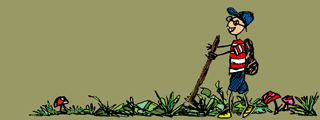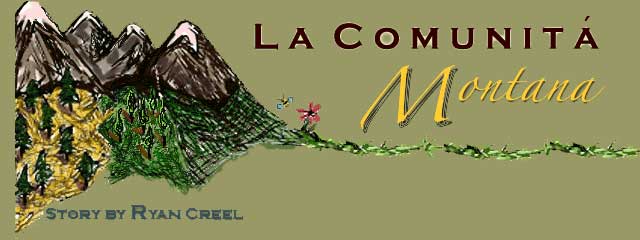
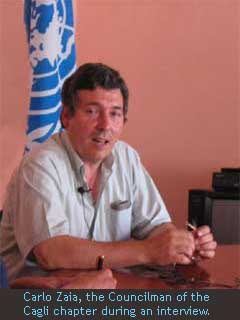
A closer look reveals the two rivers: the Basso and Burano, originating at some distant spring and cultivating this land with the flow of fresh water. Further still, the sudden rise in elevation leaves the quiet Cagli far below. These mountains serve as reference points for a passing traveler, alllowing him to pinpoint the largest town in the Le Marche region.
An organization dedicated to the preservation and management of Cagli's wilderness is based in the center of old Cagli. The Comunitá Montana, a national organization, is comparable to the United States' National Park Service(NPS), but the primary difference between the two lies in the youth of the Comunitá Montana. Founded in the 1970s, it has evolved into the organization that governs the mountains that surround this town of about ten thousand people.
The Comunitá Montana is formed locally by the connection of five or more comuni. Comune is the Italian equivalent of a municipality; it denotes a local police, mayor and general jurisdiction. Cagli is the home of this area's Comunitá Montana Catria e Nerone because it is the largest comune of the designated territory and it is located at the base of Mount Nerone and Mount Catria. A central office is appointed to serve the people and protect the area’s natural features. Each office appoints an elected official or president to serve a five year term.
A second, but more significant, difference exists between the United States' NPS and the Comunitá Montana. This organization is divided by political affiliation. Participating parties include: Democratici, Forza Italia, Communista and Republiccista, among others. Monthly conferences are held in Cagli where the political division is most evident. Members argue over the seating and the priority of issues.
Carlo Zaia is the councilman of the Cagli chapter; his official title is Assesore. He is a member of the Communist party in Cagli. He was formerly in the minority of the Comunitá Montana, but in the last eight months, his party has risen to the majority. He was appointed the position of Assessore.
The two mountains are the primary responsibilities of the Comunitá Montana in Cagli. They provide maps, trail maintenance and some certifications. Geological evolution has produced photogenic country sides and subterranean caverns. The caverns hold rare fossils and other treasures that suggest a very different Cagli once existed. One surprising finding included the skeleton a polar bear.
Cagli's rivers are also under the jurisdiction of the Comunitá Montana. Their involvement is less with the Basso and Burano rivers, but this may be a result of the low water levels. Canoeing is possible in the heights of Monte Nerone, but these rivers contribute primarily to the scenic quality of this region.

The Comunitá Montana is responsible for the protection of the indigenous botanicals. Tree cutting and mushroom collection without the appropriate license are just two of the practices prohibited by this organization. As difficult as it may be to monitor such behaviors, fines are posted to protect the various landscapes of Cagli.
Trail maintenance is another aspect of the Comunitá Montana's service and dedication to the Cagliese. Employment is seasonal in this regard. Various agencies contribute to staff this enormous effort.
The Comunitá Montana is funded primarily by region. Cagli's chapter is made possible by federal funding from Le Marche region. Supplemental funds are made possible by donations and other federal grants. Donations are certainly welcomed, but Carlo Zaia ensured that the practice is unpopular.
The elderly Cagliese are able to take advantage of nursing and assisted living facilities provided by the Comunitá Montana. These establishments scatter the surrounding areas. This combination of services is unexpected, but they are joined by provincial funds and a common concern for the Cagliese.
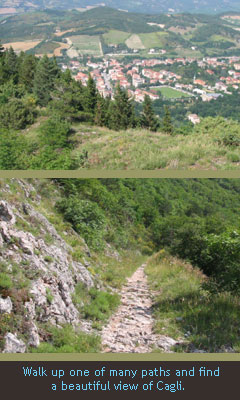
Most Cagliese take advantage of the beautiful landscapes by hiking the scenic trails of the mountains that have shaped Cagli. This town's location in the mountains has affected the attitudes and behaviors of the Cagliese. They share a common concern for the well-being of the wilderness. Recent years have brought an increase in industrialization and energy consumption to this region. Cagli has responded with environmentally conscious attitudes and new policies regarding recycling and conservation. Despite tremendous improvements, Carlo Zaia admits, they could do more.
The Comunitá Montana does not sponsor programs geared toward the Cagliese youth. However, one such program does exist, independent of this organization. Young Cagliese have been known to enjoy the outdoors by hiking the winding mountain trails.
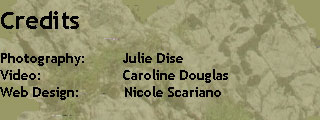
A majority of the programs provided by the Comunitá Montana are free to the Cagliese and any traveler who may require them. Only an official certification by the Comunitá Montana requires a fee. There are rare and valuable mushrooms, particularly truffles, indigenous to the Le Marche region that compliment Italian cuisine very well. Retrieving these natural resources is difficult due to the abundance of poisonous funghi. It is imperative to obtain the appropriate knowledge before one can legally attempt to collect them. This instruction and the corresponding fee will provide the required license.
Rifle hunting is permitted in certain areas and a license is required. The game consists of wild boar, pheasant and rabbit. The Comunita Montana offers no protection to the wildlife.
Cagli's Comunitá Montana is preparing to open a new office in the near future. More office space is the only objective in this endeavor. Financial support has been offered to Cagli's historical museum. This organization is very supportive of the preservation of local history. A similar museum exists in nearly every town throughout Italy, varying in size and resources.
Recycling and natural conservation are being attributed increasing priority in the approaching years.
The Comunitá Montana's obvious concern for the present and their preservation of the past lead one to inquire about the future of this young organization. Unfortunately, a complete definition of the role of the Comunitá Montana does not yet exist. A principal objective in the approaching years will be to determine this once and for all.***
